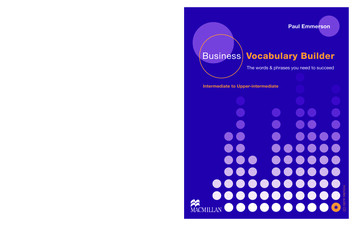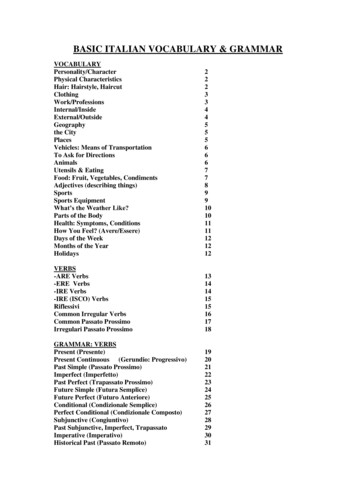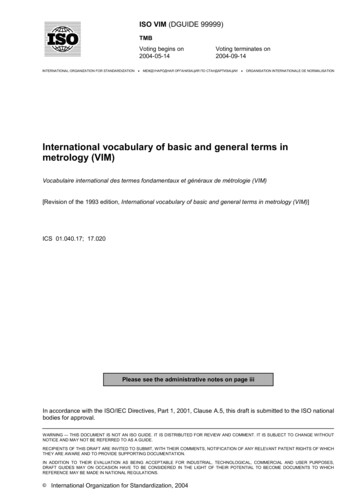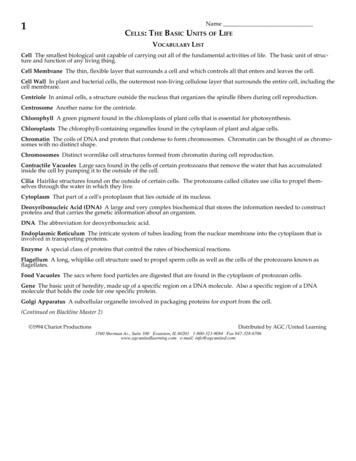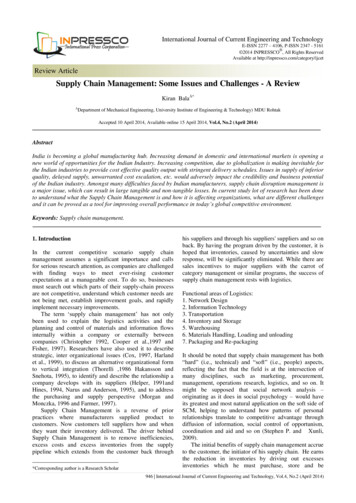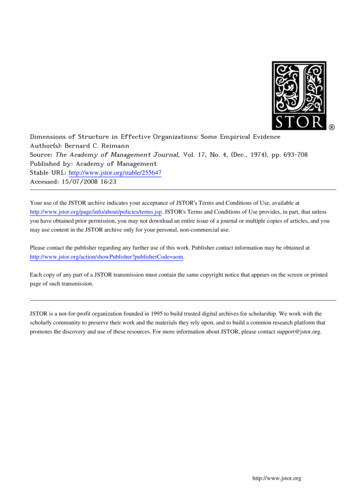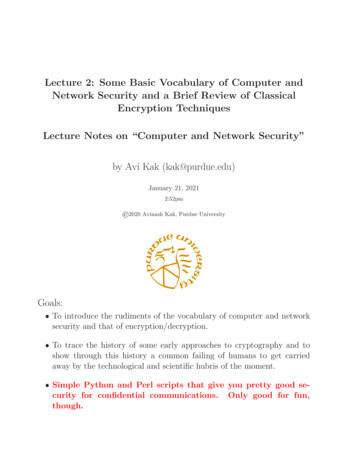
Transcription
Lecture 2: Some Basic Vocabulary of Computer andNetwork Security and a Brief Review of ClassicalEncryption TechniquesLecture Notes on “Computer and Network Security”by Avi Kak (kak@purdue.edu)January 21, 20212:52pm 2020 Avinash Kak, Purdue UniversityGoals: To introduce the rudiments of the vocabulary of computer and networksecurity and that of encryption/decryption. To trace the history of some early approaches to cryptography and toshow through this history a common failing of humans to get carriedaway by the technological and scientific hubris of the moment. Simple Python and Perl scripts that give you pretty good se-curity for confidential communications.though.Only good for fun,
CONTENTSSection TitlePage2.1Some Basic Vocabulary to Get Us Started32.2Building Blocks of Classical Encryption Techniques152.3Caesar Cipher162.4The Swahili Angle .182.5Monoalphabetic Ciphers202.5.12.62.6.12.7A Very Large Key Space But .22The All-Fearsome Statistical Attack23Comparing the Statistics for Digrams and TrigramsMultiple-Character Encryption to Mask Plaintext Structure:The Playfair Cipher25272.7.1Constructing the Matrix for Pairwise Substitutionsin the Playfair Cipher282.7.2Substitution Rules for Pairs of Characters in thePlayfair Cipher292.7.3How Secure Is the Playfair Cipher?312.8Another Multi-Letter Cipher: The Hill Cipher2.8.12.9How Secure Is the Hill Cipher?Polyalphabetic Ciphers: The Vigenere Cipher2.9.1How Secure Is the Vigenere Cipher?343637392.10Transposition Techniques422.11Establishing Secure Communications for Fun (But Not forProfit)442.12Homework Problems572
Computer and Network Security by Avi KakLecture 2Back to TOC2.1 SOME BASIC VOCABULARY TO GETUS STARTEDI’ll start this section with some basic vocabulary of encryption anddecryption, since that’s the primary focus of the beginning lecturesin this series. Subsequently, I’ll also review some of the basicvocabulary of computer and network security from a more systemsperspective.So let’s start with encryption and decryption:plaintext: This is what you want to encryptciphertext: The encrypted outputenciphering or encryption: The process by which plaintext is convertedinto ciphertextencryption algorithm: The sequence of data processing steps that go intotransforming plaintext into ciphertext. Various parameters used by anencryption algorithm are derived from a secret key. In cryptography forcommercial and other civilian applications (and, not uncommonly, thesedays even for military applications), the encryption and decryptionalgorithms are placed in the public domain. [Just think of the consequences of keepingthe algorithms secret. First and foremost, a secret algorithm is less likely to be subject to the same level of3
Computer and Network Security by Avi KakLecture 2testing and scrutiny that a public algorithm is. And, assuming that a secret algorithm is used for allcommunications within an organization, what if a disgruntled employee posted the algorithm anonymously onWikiLeaks?]secret key: A secret key is used to set some or all of the various parametersused by the encryption algorithm. The important thing to note isthat, in classical cryptography, the same secret key is used forencryption and decryption. It is for this reason that classicalcryptography is also referred to as symmetric key cryptography. Onthe other hand, in the more recently developed cryptographicalgorithms, the encryption and decryption keys are not onlydifferent, but also one of them is placed in the public domain.Such algorithms are commonly referred to as asymmetric keycryptography, public key cryptography, etc.deciphering or decryption: Recovering plaintext from ciphertextdecryption algorithm: The sequence of data processing steps that go intotransforming ciphertext back into plaintext. In classical cryptography,the various parameters used by a decryption algorithm are derived fromthe same secret key that was used in the encryption algorithm.cryptography: The many schemes available today for encryption anddecryptioncryptographic system: Any single scheme for encryption and decryptioncipher: A cipher means the same thing as a “cryptographic system”4
Computer and Network Security by Avi KakLecture 2block cipher: A block cipher processes a block of input data at a time andproduces a ciphertext block of the same size.stream cipher: A stream cipher encrypts data on the fly, usually one byteat at time.cryptanalysis: Means “breaking the code”. Cryptanalysis relies on aknowledge of the encryption algorithm (that for civilian applicationsshould be in the public domain) and some knowledge of the possiblestructure of the plaintext (such as the structure of a typical inter-bankfinancial transaction) for a partial or full reconstruction of the plaintextfrom ciphertext. Additionally, the goal is to also infer the key fordecryption of future messages.The precise methods used for cryptanalysis depend on whether the“attacker” has just a piece of ciphertext, or pairs of plaintext andciphertext, how much structure is possessed by the plaintext, and howmuch of that structure is known to the attacker.All forms of cryptanalysis for classical encryption exploit the fact thatsome aspect of the structure of plaintext may survive in the ciphertext.key space: The total number of all possible keys that can be used in acryptographic system. For example, DES uses a 56-bit key. So the keyspace is of size 256, which is approximately the same as 7.2 1016.brute-force attack: When encryption and decryption algorithms arepublicly available, as they generally are, a brute-force attack meanstrying every possible key on a piece of ciphertext until an intelligibletranslation into plaintext is obtained.5
Computer and Network Security by Avi KakLecture 2codebook attack: In general, a codebook is a mapping from the plaintextsymbols to the ciphertext symbols. In old times, the two endpoints of amilitary communication link would have the same codebook that wouldbe composed of sheets, with a different sheet to be used for each day. Ina codebook attack, the attacker tries to acquire as many as possible ofthe mappings between the plaintext symbols and the correspondingciphertext symbols. The data thus accumulated can give the attacker aheadstart in breaking the code. [In modern times, you can think of a codebook as themapping between the plaintext bit blocks and the ciphertext bit blocks, with a ciphertext bit block beingrelated to the corresponding plaintext bit block through an encryption key. If the size of the bit blocks issmall enough, an attacker may be able to break the code (meaning, find the encryption key) from therecorded mappings between the plaintext bit blocks and the ciphertext bit blocks. As a trivial example,consider an 8-bit block cipher that scans the plaintext in blocks of 8 bits. If we can construct a codebookwith mappings for all 256 different possible bit blocks, we have broken the cipher.]algebraic attack: You express the plaintext-to-ciphertext relationship as asystem of equations. Given a set of (plaintext, ciphertext) pairs, you tryto solve the equations for the encryption key. As you will see,encryption algorithms involve nonlinearities. In algebraic attacks, oneattempts to introduce additional variables into the system of equationsand make nonlinear equations look linear.time-memory tradeoff in attacking ciphers: The brute-force and thecodebook attacks represent two opposite cases in terms of time versusmemory needs of the algorithms. Pure brute-force attacks have verylittle memory needs, but can require inordinately long times to scanthrough all possible keys. On the other hand, codebook attacks can inprinciple yield results instantaneously, but their memory needs can behumongously large. Just imagine a codebook for a 64-bit block cipher;it may need as many as 264 rows in it. In some cases, by trading offmemory for time, it is possible to devise more effective attacks that aresometimes referred to as time-memory tradeoff attacks. [As a specific example oftime-memory tradeoff, we may be able to reduce the time taken by a brute-force attack if we use memory to6
Computer and Network Security by Avi KakLecture 2store intermediate results obtained from the current computational steps (assuming they can help us avoidunnecessary search later during the computations). You will see examples of such tradeoffs in Lecture 24when we talk about password cracking with rainbow tables.]cryptology: Cryptography and cryptanalysis together constitute the areaof cryptology***********That brings us to the vocabulary related to the systems side ofcomputer and network security. For this vocabulary, I am going toborrow significantly from Google’s Android Security Reports. Youcan download the latest report oogle Android Security 2018 Report Final.pdfSo here we go:backdoor: A backdoor allows an intruder to get inside a networked devicewithout user authentication credentials. Backdoors may be created bymalware that a user may inadvertently install in the device through aphishing attack. Backdoors may also be created by exploitingvulnerabilities in the security protocols used in a networked device.commercial spyware: Any application that transmits sensitiveinformation off the device without user consent and does not display apersistent notification that this is happening. Legitimate forms of theseapps can be used by parents to track their children. However, theseapps can be used to track a person (a spouse, for example) without7
Computer and Network Security by Avi KakLecture 2their knowledge or permission if a persistent notification is notdisplayed while the data is being transmitted.denial of service: As the name implies, the goal of a denial-of-serviceattack is to prevent legitimate users from accessing a network resource.Malware planted or inadvertently installed in a machine may turn it intoa device for mounting a denial-of-service attack on a network resource.hostile downloader: An application that is not in itself potentiallyharmful, but downloads other potentially harmful apps. For example, agaming app that does not contain malicious code, but persistentlydisplays a misleading “Security Update” link that installs harmful apps.mobile billing fraud: An application that charges the user in anintentionally misleading way. Mobile billing fraud is divided into 1.sms fraud, 2. call fraud, and 3. toll fraud based on the type offraud being committed.1. sms fraud: An application that charges users to send premium SMS withoutconsent, or tries to disguise its SMS activities by hiding disclosure agreements orSMS messages from the mobile operator notifying the user of charges orconfirming subscription. [The text messages normally used by most of us typically cost little tonothing. However, there is another category of text messages — for downloading ringtones, music clips,adult content, games, etc., and also for voting in TV shows based on performance competition — thatare used for what are known as Mobile Premium SMS/MMS services. Using such services leads tonoticeable charges on your phone bill. By law, the phone numbers for such services must begin with“19”.]Some apps, even though they technically disclose SMS sending behavior introduceadditional tricky behavior that accommodates sms fraud. Examples of thisinclude hiding any parts of disclosure agreement from the user, making themunreadable, conditionally suppressing SMS messages the mobile operator sends toinform user of charges or confirm subscription.2. call fraud: An application that charges users by making calls to premium-ratetelephone numbers without user consent. [Premium-rate telephone numbers are used by the8
Computer and Network Security by Avi KakLecture 2providers of directory services, adult chat lines, and other business organization to provide services forwhich the charges appear on your phone bill. The phone company sends a portion of what is charged tothe service provider.]3. toll fraud: An application that tricks users to subscribe or purchase content viatheir mobile phone bill.Toll Fraud includes any type of billing except Premium SMS and premium calls.Examples of this include: Direct Carrier Billing, WAP (Wireless Access Point), orMobile Airtime Transfer.WAP fraud is one of the most prevalent types of Toll fraud. WAP fraud caninclude tricking users to click a button on a silently loaded transparent WebView.Upon performing the action, a recurring subscription is initiated, and theconfirmation SMS or email is often hijacked to prevent users from noticing thefinancial transaction.phishing: An application that pretends to come from a trustworthy source,requests a user’s authentication credentials and/or billing information,and sends the data to a third party. This category also applies to appsthat intercept the transmission of user credentials in transit. Commontargets of phishing include banking credentials, credit card numbers, oronline account credentials for social networks and games.mobile unwanted software (MUwS): Any application that collects atleast one of the following without user consent: Information about installed applications Information about third-party accounts Names of files on the deviceThis includes collecting the actual list of installed applications as wellas partial information like information about currently active apps.9
Computer and Network Security by Avi KakLecture 2privilege escalation: An application that compromises the integrity of thesystem by breaking the application sandbox, or changing or disablingaccess to core security-related functions. Privilege escalation can allowan app to steal credentials from other apps and to prevent its ownremoval. [The Meltdown and Spectre processor vulnerabilities — especially the former — thatrecently burst into the scene could, for example, be used for privilege escalation. These vulnerabilitiesare related to how
Computer and Network Security by Avi Kak Lecture2 block cipher: A block cipher processes a block of input data at a time and produces a ciphertext block of the same size. stream cipher: A stream cipher encrypts data on the fly, usually one byte at at time. cryptanalysis: Means “breaking the code”. Cryptanalysis relies on a
